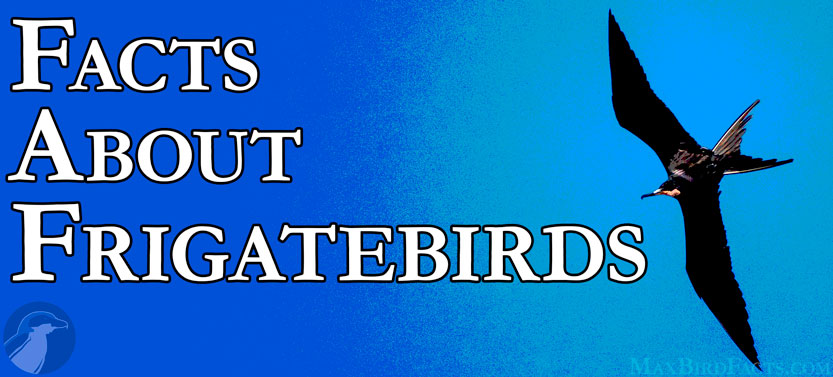Frigatebirds (family Fregatidae) are among my favorite birds to see by the sea. These massive black seabirds are a shocking sight compared to the typical white and gray gulls that dart among the waves.
With their long, sharp wings, deeply forked tails, and slender beaks, Frigatebirds are one of the easiest pelagic birds to identify.
Before we get into the bird facts, I want to state that I will be using the words Frigatebird and Frigate Bird interchangeably throughout this article. The scientifically correct form of the name is Frigatebird, but through my research for this article, I found that many people split the name into its two components.
So, with that out of the way, let’s dive into 12 Fascinating Facts About Frigate Birds!
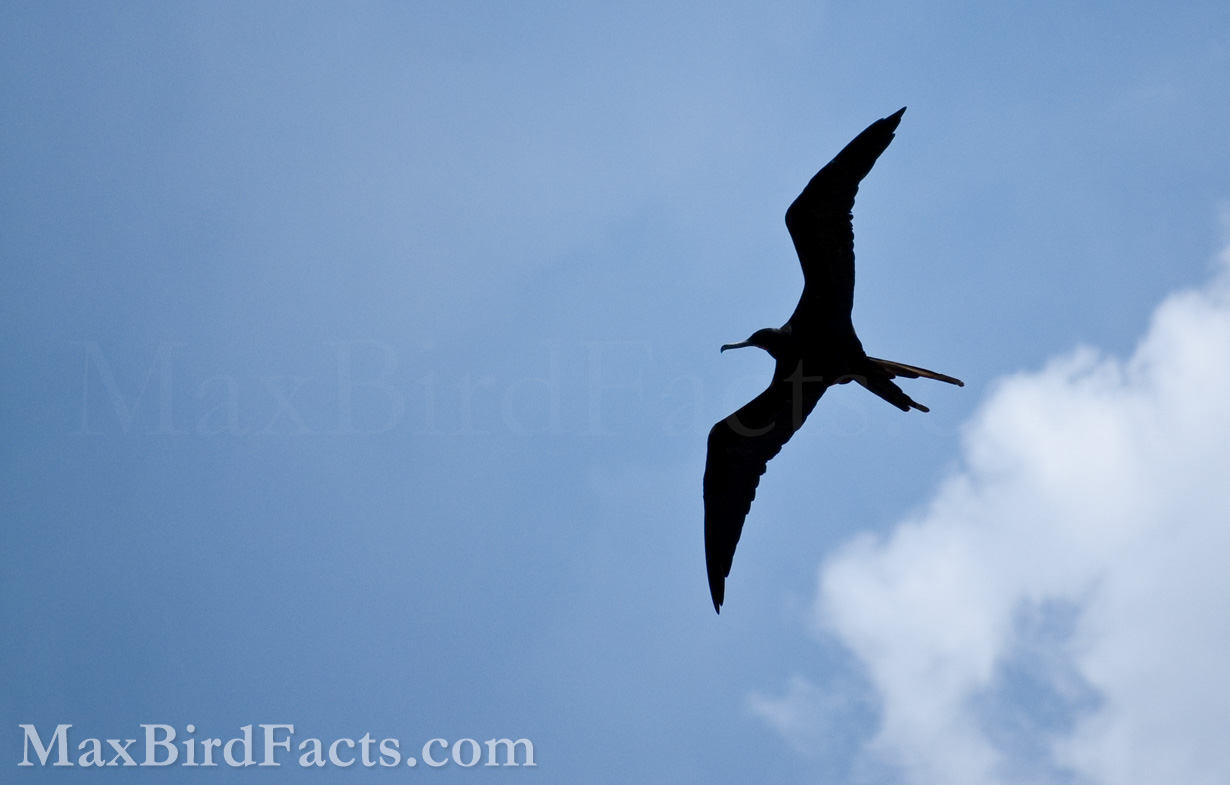
1. Frigatebirds don’t have waterproof feathers.
Probably the most shocking fact about Frigatebirds is their lack of waterproof feathers. I couldn’t believe this at first because how could a bird that spends the majority of its life soaring over the seas not have water-repellant feathers?
Yet, this is true: Frigate Birds lack waterproof feathers.
The reason why Frigates’ feathers aren’t waterproof isn’t fully known, but it likely has to do with efficiency. Everything about the avian world revolves around efficiency, from saving weight to expending less energy while flying or adaptations to process seawater into something drinkable.
Frigatebirds are extremely successful in their lifestyle, which we will discuss more throughout this article. Why would they need to switch because of the success they’ve found while not needing waterproof feathers?
The time and effort it takes to preen and maintain this oily coating would take a lot of work to do while flying. This is evident when looking at how small their uropygial gland is.
Compared to other seabirds, the Frigatebird’s uropygial, or oil, gland is effectively nonexistent. This structure’s near-complete functional loss clearly shows this bird can succeed without waterproof feathers.
2. Frigatebirds are parasites.
Because Frigatebirds’ feathers aren’t waterproof, they rarely hunt their own aquatic prey. This forces these birds to approach feeding differently, choosing to plunder from other birds.
This feeding behavior is officially referred to as kleptoparasitism, where the animal deliberately steals food from another animal when stealing costs less energy than foraging.
Though all species of Frigatebirds are capable of obtaining their own prey, they seem to revel in the chase of other seabirds. Because of their enormous size and speed, these birds can hound any other species and coerce it until they regurgitate or release their meal.
However, when the opportunity for parasitic behavior isn’t available, Frigatebirds will happily pluck fish, krill, squid, and virtually anything else that swims too close to the surface.
Because of their inability to dive, circling Frigatebirds have been a beacon to fishermen for centuries. Large black shapes darting around the sky were a clear sign to anglers that some fish were near the surface and likely being worked by predators, such as tuna and mahi-mahi from below.
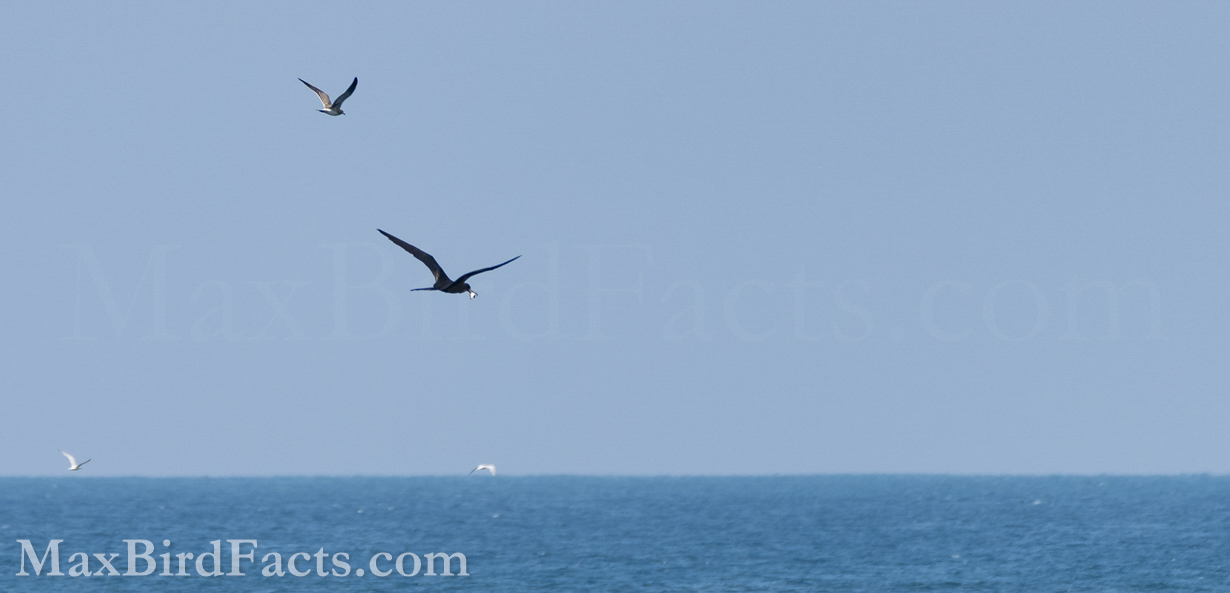
3. The name “Frigatebird” means “warship.”
Frigatebirds were a favorite among mariners in the 16th and 17th centuries. The French referred to them as La Frégate, translating to “The Frigate” or “The Warship.” The Spanish called Frigatebirds Rabiforçado, meaning “Forked Tail.”
English sailors called the Magnificent Frigatebird “Man-of-War birds.” This view of these birds being warships was an easy connection for the men exploring the New World.
For clarification, a Frigate is a small ship that is quick and maneuverable yet heavily armed and ready for a fight at a moment’s notice. These speedy ships were often used for scouting missions into potentially dangerous areas or for quick raiding parties against enemy ships.
So, with the Frigatebird’s propensity to harass and steal their meals from other seabirds, it is easy to see why they earned these titles from sailors.
This reputation of the Frigatebird lives on today with nicknames of Pirate Bird, Pirate of the Sky, and even the original Man-of-War Bird still in common use. The original French name of La Frégate is even the origin of these birds’ taxonomic family and genus names, Frigidae and Fregata, respectively.
4. Frigate Birds have webbed feet.
Another odd feature that points to this family’s past is the inclusion of webbed feet on a bird that can’t touch the water.
Truthfully, these feet are in the totipalmate foot arrangement, where all four digits are connected with a thin membrane of skin, and the first toe (equivalent to your thumb) is rotated forward and towards the body, making it so all four toes point forward.
The simple answer to why Frigate Birds have webbed feet is due to their relatives that share the totipalmate foot style: Anhingas, Boobies, Cormorants, and Gannetts.
Suliformes is a fairly small order of birds, but one common trait they share is their foot arrangement. This structure was the cause of some interesting taxonomic placements before widespread genetic testing.
The official classification of the order Suliformes didn’t occur until 2010, and before this, many of these species were under the Pelecaniformes order.
It is easy to see why this was the case because Pelicans seem to share many physical characteristics in the families currently belonging to Pelecaniformes and the current order of Suliformes.
Pelicans share this totipalmate foot style with Suliformes, making their placement somewhat challenging. Current genetic studies show that Pelicans are more related to Herons and Ibis than Frigatebirds and Cormorants, so they remain in Pelecaniformes.
Yet, this shared adaptation for swimming after fish clearly points to a common ancestor between Pelicans (family Pelecanidae) and Suliformes.
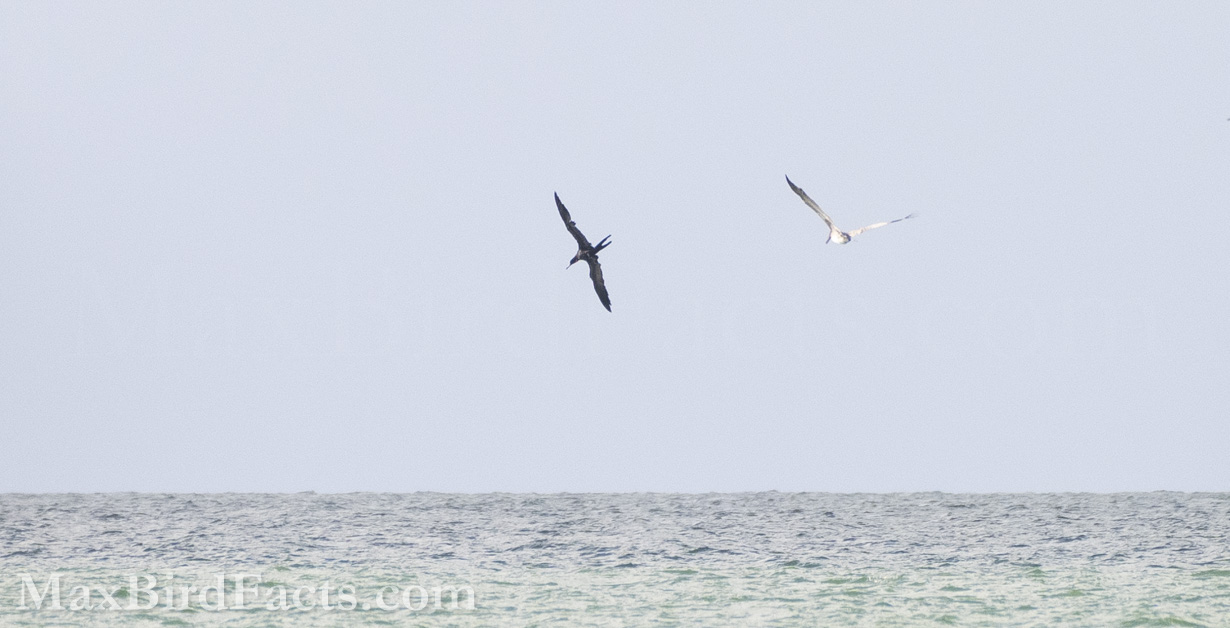
5. Frigatebirds spend so much time flying they can literally do it in their sleep.
Spending months aloft over the ocean, never able to touch the water to rest, Frigatebirds can sleep while they fly. This might sound impossible, but there are actually many species of birds that sleep on the wing.
In 2016, researchers found that Great Frigatebirds (Fregata minor) can fly continuously for two months without landing or crashing into the waves. Because of this discovery, the scientists captured fifteen of these birds from their Galapagos nesting grounds and surgically implanted electroencephalographs into their skulls to measure their brain’s electrical impulses.
What they found was very interesting. While the Frigatebirds were on the ground, they would sleep twelve hours a day through one-minute intervals.
However, when the birds were flying, they only slept for a total of forty-five minutes via ten-second breaks. The researchers also measured that only half of the bird’s brain rested during these ten-second respites, most likely to prevent them from crashing.
These tests have been conducted on several other species, including Swifts that cannot land or perch on branches because of how reduced their feet have become. This ability to partially rest while the rest of the body is essentially on auto-pilot is crucial for birds that cannot land.
I won’t be surprised when new research says that nearly all migratory species do this function of micro-naps while making their seasonal odysseys.
6. Frigate Birds have some of the most energy-efficient wing designs among birds.
With their requirement of staying aloft for weeks or months, it’s no wonder that the Frigate Bird’s wings are particularly energy-efficient.
The wing style of the Frigate is the quintessential example of a high aspect ratio wing. The high aspect ratio wing design is usually very long and thin and ends at a sharp point. This style is ideal for long periods of soaring on thermals or ocean winds.
The shape of the Frigatebird’s wings also means they can produce a massive amount of thrust when actively flying. With an average wingspan of over seven-and-a-half feet, the only other bird that rivals the Frigate in size are albatross.
Still, the Frigatebird is much lighter than the larger albatross, allowing them to gain on anything flying over the waves. Frigatebirds boast the claim of having the largest wingspan-to-weight ratio of any avian species.
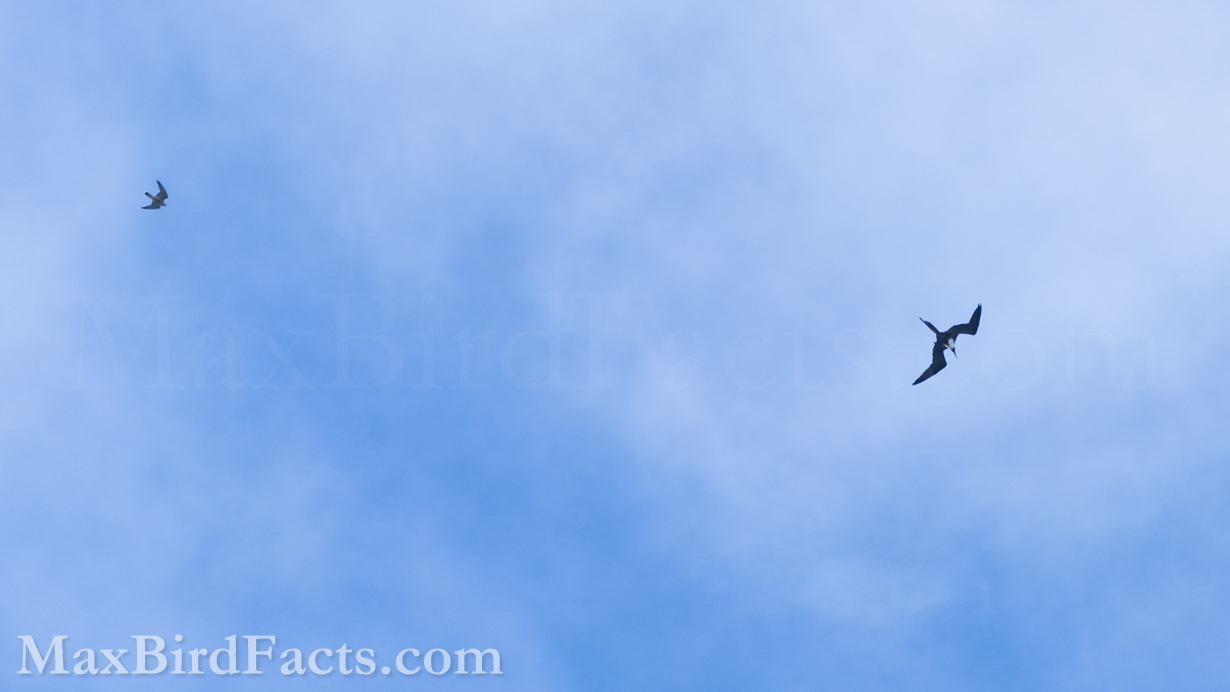
Further, their forked tail is an indicator of their aerial prowess. Many species of swallows, swifts, kites, terns, flycatchers, and hummingbirds have forked tails, but what does this have to do with their flying capabilities?
The forked tail of the Frigatebird allows it to create immense drag for tight turns when extended but has nearly zero effect while it is folded.
This drag is vital to quick maneuvers while chasing down fish at the water’s surface or harassing a gull for its meal. And, when this need for maneuverability isn’t necessary, the Frigate can fold its tail feathers together to run perfectly streamlined with its body again.
Even the black aspect of the Frigatebird’s feathers also aids in their flying. Though this is still an emerging subject of research, some studies are finding that birds with black wings are up to 20% more efficient at soaring than birds with white feathers.
The current theory on how this works is that the heat produced by the black feathers absorbing sunlight heats the air running over the wing’s surface, making it easier to slice through.
To put this into perspective, imagine slicing through a block of butter. Taking a cold stick of butter and cutting it with a cold knife will take more effort than if the blade is hot. This isn’t a perfect way to describe the phenomenon, but it should give you the right idea.
So, with perfectly shaped high aspect ratio wings, a deeply forked tail, and black wings to make soaring that much easier, it’s clear to see how Frigatebirds dominate the skies they prowl.
7. Frigate Birds’ wings form the shape of a squished “M” when viewed head-on.
This might seem like an odd fact to include on this list, but hear me out. On visiting the Florida Keys Hawk Watch, there was a constant issue with initially seeing a dark bird flying in the distance and expecting it to be a raptor, only to find out it was a Magnificent Frigatebird (Fregata magnificens).
However, after a few misidentifications, the researchers at the Hawk Watch told me that the best way to distinguish a Frigatebird from a raptor was to wait until it turned head-on with you, and its wings would form an “M.”
And, sure enough, looking through my binoculars, I could quickly determine if the bird in question was a Frigate much more confidently after gaining this knowledge. So, if you’re ever scanning the horizon looking for these scallywags, remember, M for Magnificent Frigatebird.
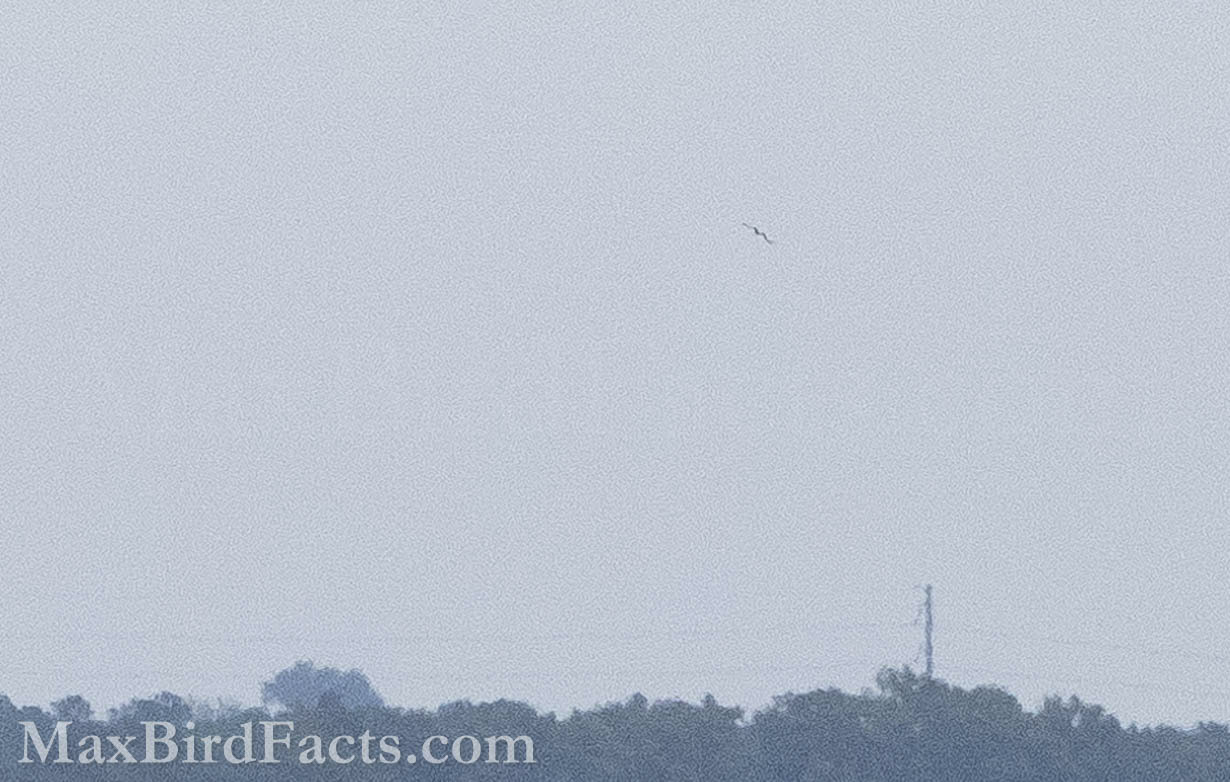
8. Frigatebirds are the only pelagic avian species that show sexual dimorphism.
Virtually all gull, tern, albatross, petrel, or other ocean-faring bird species have little to no distinction between sexes.
Sexual dimorphism simply means there is a noticeable difference between male and female members of a species.
Male Magnificent Frigatebirds are wholly black, except for their red gular sac, which can still be seen when deflated, while females are mostly black with a white vest and black throat. Juvenile Frigates have a white head, throat, breast, and upper belly.
This trend is also true among the other species of Frigatebirds, where female birds tend to have more white than males.
Identifying Magnificent and Great Frigatebirds on the Galapagos Islands can be very deceptive, especially in mixed roosting colonies. Males of both species are relatively the same size, sport pure black plumage, and flaunt their iconic crimson gular sacs.
The two species have a minor difference: male Magnificents have a purplish iridescence to their feathers, while male Greats have a green luminescence. However, the female birds are the key to determining which species you observe.
Female Magnificient Frigatebirds have bluish skin around their eyes, while female Great Frigatebirds have red orbital flesh.
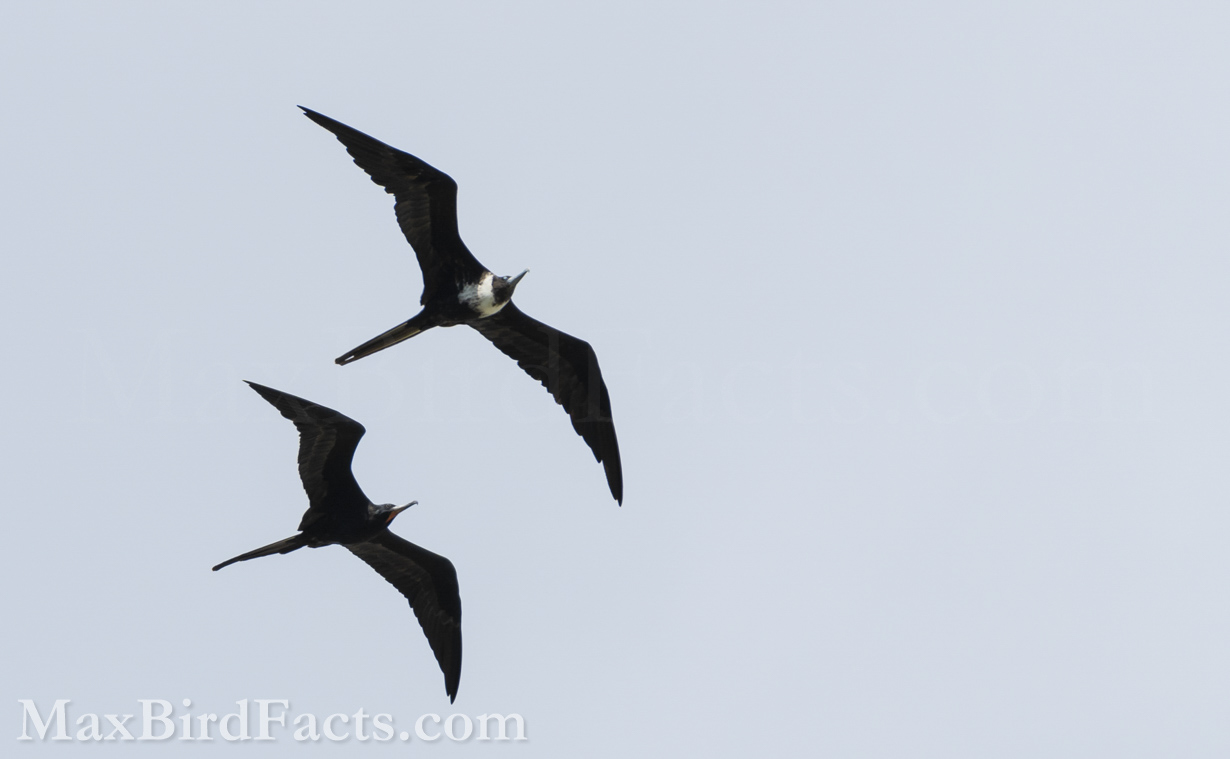
9. Male Frigatebirds use their large ballon-like gular sac to attract mates.
While both male and female Frigatebirds have gulars (a fleshy extension of the throat), the male’s gular is massive. This structure can be inflated to the size of a human head and is vital to the Frigatebird’s mating display.
Male Frigates will station themselves on islands, inflate their gular sacs, and point their bills toward the sky while spreading their wings so the crimson-red flesh of their ballon-like throat adornment is readily apparent to any passing female birds.
Once a female Frigatebird spots this display, he produces a low, staccato drumming sound by bouncing its bill against its gular sac.
If the female bird deems the male’s display adequate and the proposed nesting location satisfactory, she will land in front of her suitor. They then conduct a head-shaking ritual where male and female birds lower their heads and come together until their necks touch and sway their heads from side to side.
Once the pair has officially formed, the male sets off to gather nesting material for the female to build. Some males steal from others, returning with branches and twigs like they steal fish from gulls and pelicans.
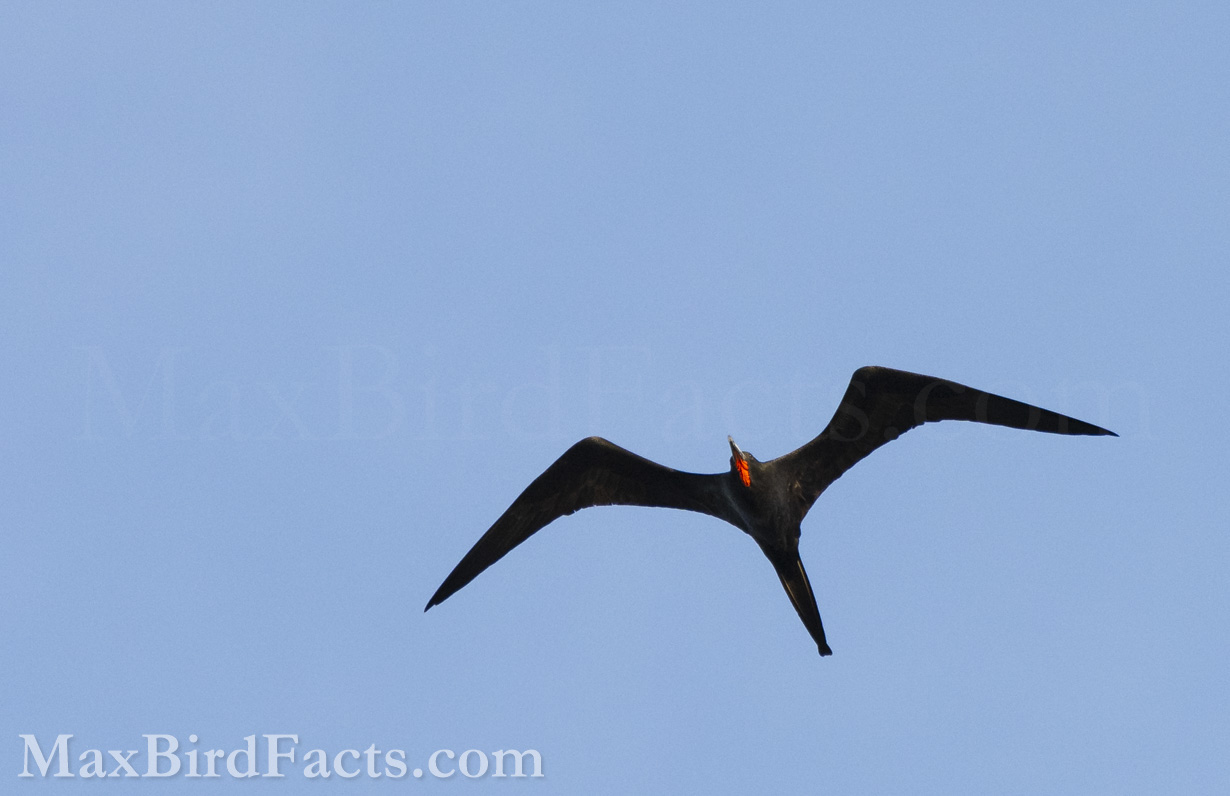
10. Frigatebirds are average parents but excellent mothers.
After nearly two months of shared incubation from both parents, the Magnificent Frigatebird chicks remain in the nest for an additional six months. Both parents take turns leaving the nest to hunt or steal food while the other remains to protect their young.
Once fledged, the mother bird will still feed their chicks until they are about a year old. However, the male birds typically leave soon after or just before their offspring fledge.
Though the parent birds don’t hold strong pair bonds year-round, they remain fairly loyal during the nesting season. Extra-pair relations are fairly rare with Frigatebirds once the female chooses her mate.
Still, if one bird leaves or dies, the other will abandon the nest after a few days of mourning.
The reason Frigatebirds can afford to have fairly weak pair bonds is due to their sexual dimorphism. Since male and female birds are easily distinguished, the need for a guaranteed meeting of the opposite sex isn’t as vital.
Pelagic birds like the Wandering Albatross (Diomedea exulans) are well known for their incredibly strong pair bonds and exceptionally high nest site fidelity that can last for the entire lifetime of both birds. This is likely due to the visual similarities between males and females, where the need for a guaranteed partner and place to meet after a year of exploring the vast Southern Sea was vital for the species’ success.
11. There are 5 species of Frigatebirds.
The Ascension, Christmas Island, Great, Lesser, and Magnificent Frigatebirds all soar over nearly every equatorial ocean.
Only two species, the Ascension and Christmas Island Frigates, remain extremely local. The Ascension Frigatebird is only found on Ascension Island. This island is almost perfectly between the continents of South America and Africa, being 1,400 and 1,900 miles away from each, respectively.
The Christmas Island Frigatebird is a little more spread out, calling Cambodia, Bruni, Malaysia, Thailand, Indonesia, and Christmas Island home. Females and juveniles have a pink bill and orbital skin, and the white belly on males easily identifies them against other Frigates.
The Great Frigatebirds primarily stick to the Pacific and Indian Oceans, with a handful of sightings in the Atlantic. Their strongholds are found in Hawaii, the Galapagos Islands, coastal Queensland, and throughout the South Pacific islands and Southeast Asia.
The Great Frigate is the only species where the male is pure-black, and the female has a gray bill where they share the skies with the Christmas Island and Lesser Frigatebirds.
The Lesser Frigatebird primarily soars in the skies of South Pacific islands (Fiji, New Caledonia, Samoa, the Cook Islands, French Polynesia, and Papua New Guinea), the northern coast of Australia, Indonesia, and the Philippines.
Like the Christmas Island Frigatebird, the female and immature Lessers have a pink bill. However, male Lesser Frigates have white wingpits that distinguish them from the other two species where they share the sky.
The Magnificent Frigatebird is the species I’m most familiar with. Spanning from Florida to Brazil in their Atlantic range to Baja California down to Ecuador and the Galapagos Islands on their Pacific expanse, these birds are a fundamental feature of the tropical skies of the New World.
As the largest species of Frigatebird, these flying pirates are happy to steal from any other bird that crosses its path, including other Frigates. As stated earlier, the Magnificent only shares space with Great Frigates in the Pacific; the female Magnificent’s blue orbital skin is the best identifying marker against the red orbital flesh of the female Great.
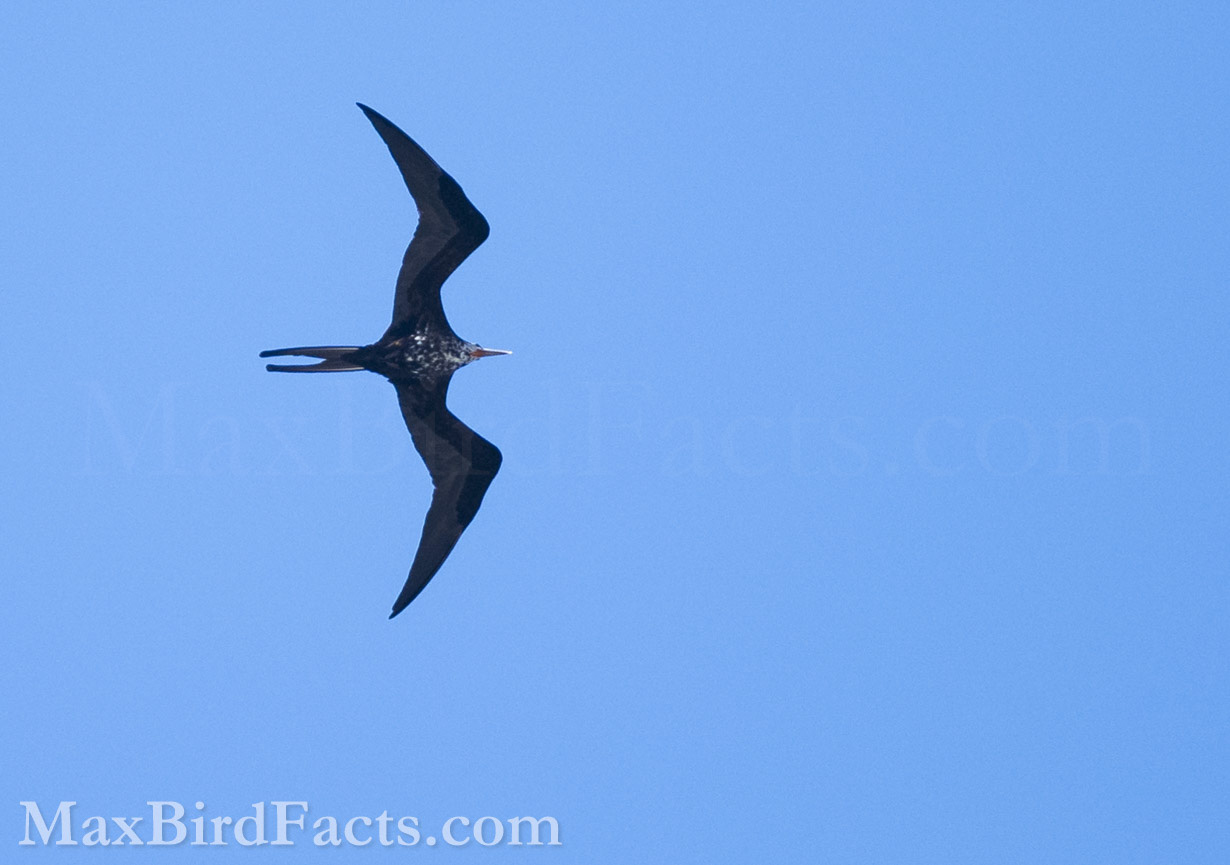
12. Christopher Columbus was the first European to describe the Magnificent Frigate Bird.
Christopher Columbus stumbled upon the New World in his voyage, searching for an eastward route to India in 1492. However, before his journey west, he stopped at the Cabo Verde Islands, roughly four hundred miles west of Senegal.
In his journal, he remarks on its parasitic behaviors on the other seabirds and notes that it “does not alight on the sea nor depart from land 20 leagues.”
Even though the Portuguese had discovered and colonized these islands in 1462, Columbus holds the oldest written account of a European observing a Frigatebird’s behavior.
Today, the populations of the Magnificant Frigatebird seem to be on a sharp decline in the Cabo Verde Islands. There have even been reports that the breeding population on these islands is as low as twelve pairs.
13. The Magnificent Frigatebird became its own species in 1914.
The Magnificent Frigatebird was officially split and recognized as a distinct species from the Ascension Frigatebird by Gregory Mathews in 1914.
Mathews was, and still is, a contentious figure in 20th-century ornithology. He notoriously split species into as many subspecies as he possibly could. Many of these proposed subspecies would be lumped back into the parent species after insufficient evidence was found to substantiate its claim.
However, if Mathews was right, then his proposed name for the subspecies would subsequently become the new species name; in this case, Magnificent Frigatebird (Fregata magnificens).
Regardless, these two species likely stemmed from the same common ancestor since they are the closest related genetically. The two species have only minor differences, primarily seen in juvenile birds.
Young Ascensions have a much more complete white pectoral band, or vest, while the juvenile Magnificent has more black creeping in from the wing-pits.
The Magnificent Frigatebird is also distinctly larger, with a wingspan of 8 feet compared to the 6.6-foot wingspan of the Ascension. The bill lengths are also notably different, with the Magnificent again being larger, though this would be a challenging identifying marker in the field.
It isn’t hard to see why the Magnificent Frigatebird was thought to simply be a larger variant of the Ascension due to their obvious similarities. Still, the split of the Magnificent from the Ascension means the Ascension can receive the protection it deserves.
With approximately 130,000 Magnificent Frigatebirds soaring the skies today, there are only between 17,000 and 21,000 Ascension Frigatebirds. Meaning there are six Magnificents for every one Ascension at their highest population estimate.
This might not seem that significant, but because the numbers of the Magnificent Frigate no longer inflate the population size of the Ascension, the IUCN lists it as a Vulnerable Species. The Ascension has the lowest number of individuals of all Frigatebird species, with the Christmas Island Frigate being second at between 2,400 and 5,000.
Thankfully, programs to help the Ascension Frigatebird have been successful. With the complete removal of feral cats and rats on Ascension Island in 2006, these birds were able to finally come home to the isle they were named after.
Since then, the populations of the Ascension Frigatebird have stabilized and even slowly started to climb. Hopefully, the future will be better for these magnificent birds.
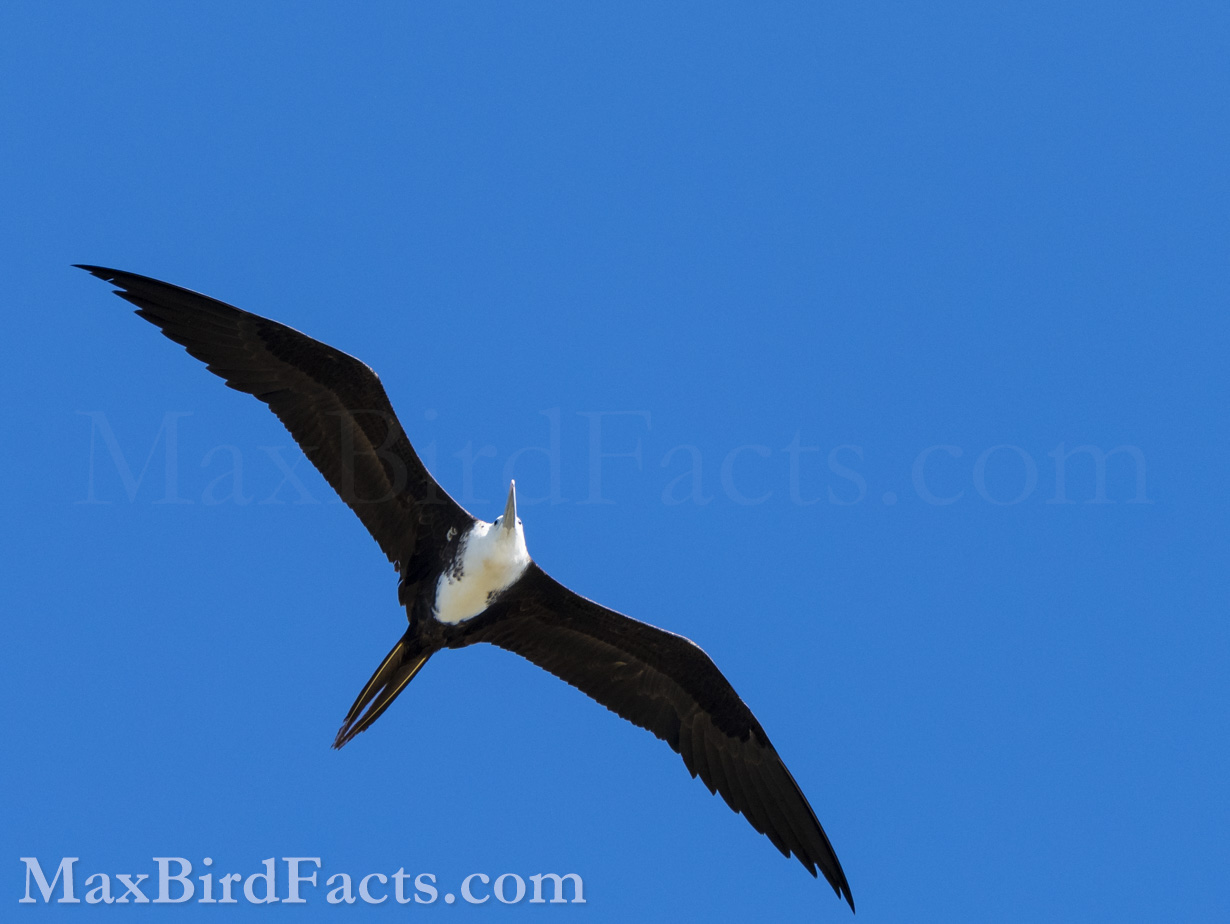
14. The Galapagos subspecies of the Magnificent Frigatebird (F. m. magnificens) was officially recognized in 2022.
The International Ornithologists’ Union (IOU) determined that the populations of Magnificent Frigatebirds on the Galapagos Islands were genetically and morphologically distinct from other populations of the species.
This caused the split and recognition of the official Galapagos Magnificent Frigatebird subspecies (F. m. magnificens) from the main subspecies of Magnificent Frigatebirds (F. m. rothschildi) found throughout the Caribbean, Mexico, and Central and South America.
Like many other species on the Galapagos, these Frigate Birds have undergone intense selective pressure from their environment.
If the story of the Magnificent splitting from the Ascension is anything to remark on, I wouldn’t be surprised if this subspecies becomes a fully recognized species from the Magnificent in the near future.
Interestingly, the species and subspecies name for the Galapagos Magnificant Frigatebird are the same: magnificens. Meaning if and when this subspecies is split and becomes the Galapagos Frigatebird, it will need an entirely new species name.
So, likely following the trend with some other endemic species to this archipelago, the Galapagos Frigatebird’s official binomial name might be Fregata galapagoensis.
Similar to the story of the Magnificent and Ascension Frigatebirds, the populations of the endemic Galapagos Magnificent Frigatebirds are exceptionally small and should warrant a separate protective status from the main parent population of Magnificents.
With an estimated 2,000 birds breeding on the islands, this would be the smallest population of Frigates in the world. However, this isn’t considering nonbreeding birds, so the number should grow to around 3,000 to 5,000 individuals.
Regardless, it is incredible to witness evolution in progress and see the potential for this icon of biological science to gain another unique species to its already diverse portfolio of flora and fauna.
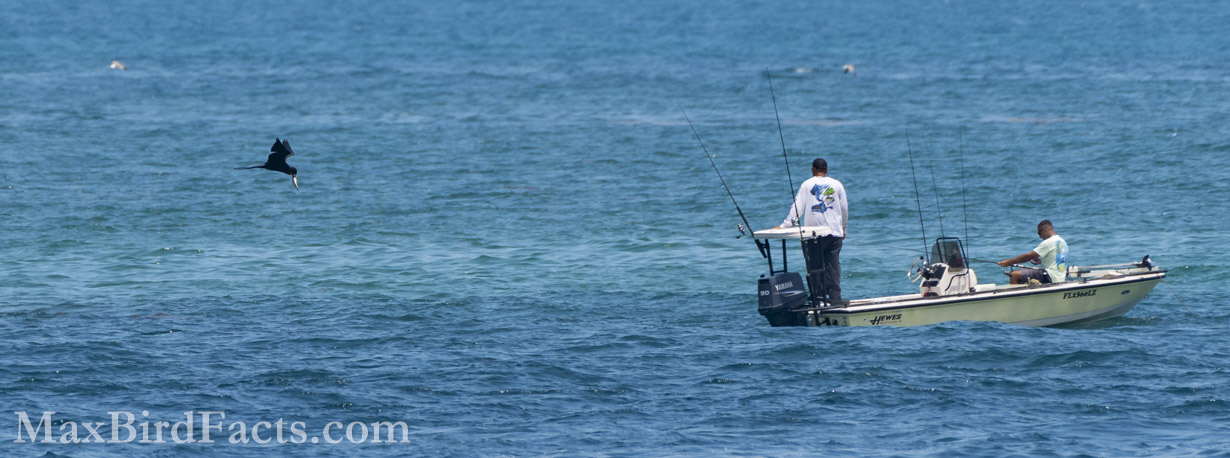
15. Magnificent Frigatebirds often get blown inland during hurricanes.
This is more of a birding tip than a true fact, but if you live in an area where hurricanes are an annual occurrence, I would strongly urge you to get outside and bird after the storm passes, and it is safe to do so.
After Hurricane Ian ran us over on September 29, 2022, my girlfriend and I found three Magnificent Frigatebirds soaring over the waves of Lake Eustis in Central Florida. Along with the Frigates, we also spotted nine species of terns and gulls that should have been flying over the Gulf of Mexico instead of a 10-square-mile lake.
So, why are these pelagic species here? Simply put, they likely were stuck in the hurricane and dropped down to the safety of this large lake when the hurricane’s path drew near it.
The terns and gulls likely dove straight for the water since they have waterproofed feathers. However, as we discussed at the beginning of this article, Frigatebirds lack waterproof feathers. So, they likely flew into the trees surrounding the lake to wait out the storm or merely soared lower and surfed the wind until it was calm enough to head back to sea.
It is also extremely possible that these seabirds flew away from the approaching storm, found a large body of water, waited until the skies cleared, and then headed back to their typical stomping grounds.
Either way, several birders in the surrounding Central Florida counties found Magnificent Frigatebirds above the waters of Lakes Apopka, Jesup, Newnans, Okeechobee, Panasoffkee, Tohopekaliga, and Weir.
Yet, when people went to look for these birds the next day, on the 30th, they had vanished. These birds were even starting to fly southwestward again while we were there, likely heading back to the Gulf.
While some species, like Forster’s Tern (Sterna forsteri) and Laughing Gulls (Leucophaeus atricilla), occasionally come inland during winter, birds like the Frigates aren’t adapted for hunting in freshwater, so returning to salty brine must have been their first priority.
So, if you live in a region where tropical storms and hurricanes are a seasonal event, and it is safe to do so, get out and look for some Frigatebirds flying over the largest lake you live near. Besides, why would you want to sit inside with the power out when you could do some post-storm birding?!
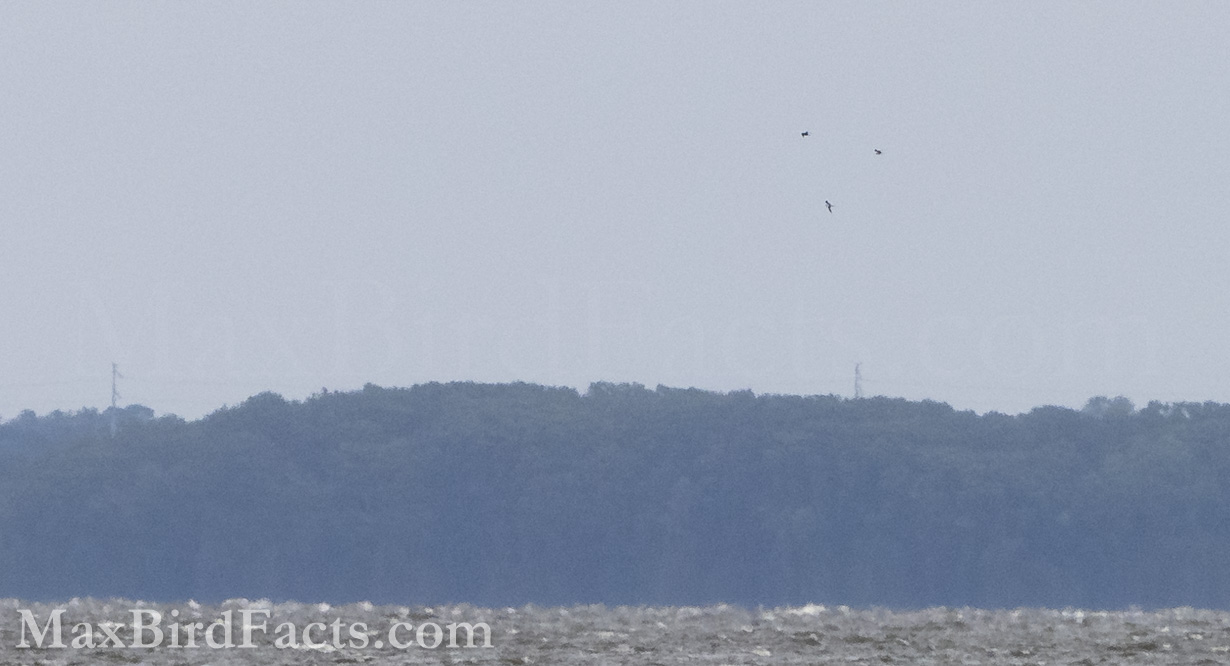
Now We Know 15 Fun Facts About Frigate Birds
From their flamboyant breeding displays to their piratic practice of harassing other seabirds for their catch and even the emerging genetic research that could lead to new species, there is something for everyone to love about Frigatebirds!
I hope you learned something new today about Frigatebirds, or Frigate Birds. I know I learned some new things while researching and writing this piece.
Finally, I hope you find the time to bird after a big storm has passed and it is safe to do so. Even areas where normal winter storms or large thunderstorms could move species into your region that typically aren’t found there. And maybe you’ll be fortunate enough to see a Frigatebird!
If you have ideas or suggestions for topics you would like me to write about in the future, feel free to leave a comment below or shoot me an email!
If you enjoyed this article, please subscribe to my email list to be the first to know when I post new articles!
Get Outside & Happy Birding
Max
